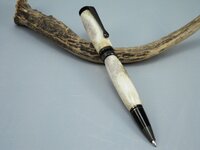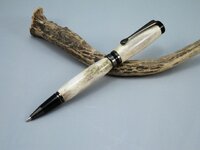I made a few phone calls, I have been inlightened by experts that all antlers are bone, and an extension of the skull, but all horns are not antlers. The difference being the Keratin being found in some horns. The velvet on the antlers contains the blood rich neutrents that supply the antler in order to grow. Caution should still be taken when drilling or sanding. I am sorry if I have missled anyone!! But it is what I was told and believed until today. After reading several journals, I questioned my own sorces and desided to get the correct answer from those that knew for sure. Thanks to the University of Wisconsin. Jim S
I wish you had a clear answer here Jim. The facts are this...sorry if UW doesn't support your findings, but the vast majority of the medical field I work in does...this crap is bad, look it up. Spend time in the ICU with patients that have turned this for years and are now dying because of it. I'll put my medical license on the wall to support the findings...will you?
You would find yourself in a better place keeping people safe rather than supporting destructive technique.
I'm happy you are 70 +??. Please help others get there too.
First, above everything else, let me publicly apologize to Jim Burr for questioning him on this subject in the first place. It is not like me to take something at face value without doing research on the subject. I asked my friend next door ,who is a retired surgen and a member of The Board Of Regents for the University of Wisconsin, Madison. He was 99.9% sure that antler was bone, but put me in touch with someone at the University that would know 100%. I was wrong in my belief for over 50 years and should have checked into it long ago. I have always said that any dust is not good for you to breathe, I don't, however, see where that is supporting destructive techniques. The original question was ,"is breathing in the dust harmful to you" My answer was YES. The rest of my statement that I gave was wrong I found out!!! Again, Jim, Please except my apopogy for questoning you on this matter. You are right, I am wrong!!!! Jim S
Jim...I wish I could give a flying crap if you were wrong or right. The fact is that I want everyone who turns, saws, grinds or sweeps out their fireplace to be safe, take care of themselves, their families and other wood workers. I work with surgeons that are great cutters and dumb as rocks when it comes to anything else...who cares. Anyone who has 3 brain cells left can look up the same info...I teach it so I don't expect your neighbor, professor, CEO or whoever to know what antler is and does.
Last time on this thread...if you care about your family, friends or yourself...you will cover up, research your material and take the means necessary to prolong your life. I do not want to see you, nor do you want to see me in an ER. Get it straight, get it right and do it right...got it? I am at your disposal from 0600 to 2000 at 559-273-1773 to explain why macrophages can't handle silicate and related material. If I don't answer, I'm asleep or taking care of the people you wonder about.


